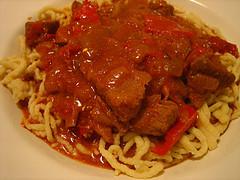
photo : Jeremy Keith
Wherever you’re staying in Austria you’re likely to come across that great all-rounder, Goulash. Originally from Hungary, Goulash is now a traditional Austrian dish.
Goulash
Introduced to Austria during the Austro-Hungarian Empire, Goulash has become a much loved dish throughout the country with regional variations reflecting the flavours of each area. For example:
- from the Tyrol comes Käserspätzle with its characteristic cheese egg noodles
- and from Vienna possibly the greatest of them all – the Fiakergoulash (also known as the Wiener goulash).
Fiakergoulash
This variant of the basic goulash gets its name from the iconic horse drawn transport and drivers of Alt Stadt Vienna – the Fiaker. The favorite meal of the Fiaker is reputed to be goulash eaten with hard-boiled eggs. They also have Knödel dumplings and sausages with it – as well as the odd piece of bread of portion of Gröstl (fried potatoes with onion). Definitely a coronary calamity in creation for the not-so calorie conscious!
But if this doesn’t worry you too much, why not have a go at making your own gorgeous goulash using the recipe below:
Ingredients:
Servings:
4-6
2 lbs/0.9 kilo marbled beef, cut in cubes
1 lb /0.5 kilo onion, diced
1/4 cup oil or 1/4 cup lard
1 tablespoon Hungarian paprika, hot if desired
2 garlic cloves, crushed
1 tablespoon tomato paste
2 cups beef or 2 cups vegetable broth
1 tablespoon caraway seed
1 tablespoon dried marjoram
2 teaspoons flour, for slurry
1 teaspoon salt (to taste)
Directions:
- Heat oil or lard in a heavy pot. Add onions and garlic and under constant stirring, sauté until very dark. Add salt.
- Add meat in batches – brown on all sides before adding next batch. Do not let the meat steam – raise the heat and add oil if necessary.
- Sauté meat until browned on all sides, add paprika, stir until fragrant – but watch out so that it doesn’t burn.
- Add broth, caraway seeds, majoram and tomato paste – simmer until meat is tender. Depending on the cut this can take up to 2 hours. If it gets too dry, add some broth – or better still, a drop or two of red wine!
- When the meat is tender make a slurry with the flour and a few teaspoons of water – add little by little, checking on the thickness of the sauce.
- Simmer until the floury taste is gone and the sauce has your preferred perfect consistency.
Enjoy with spaetzle (egg noodles), dumplings, potatoes or fresh crusty bread.
Mahlzeit!
(Mahlzeit – an Austrian pre-meal wish meaning the equivalent of ‘bon appetit’ or enjoy your meal. It’s very rude to start tucking in without having first saluted everyone at the table by saying Mahlzeit!)

